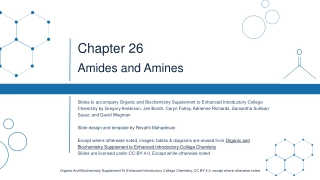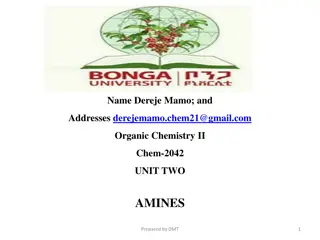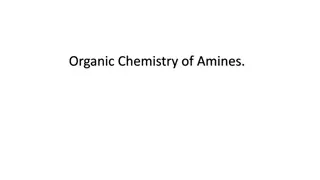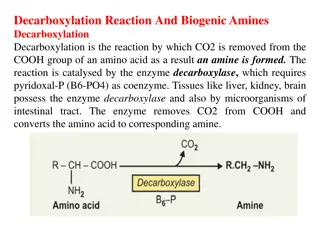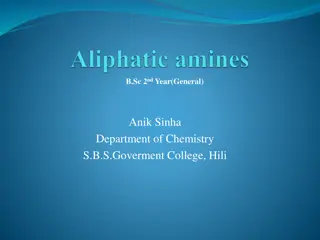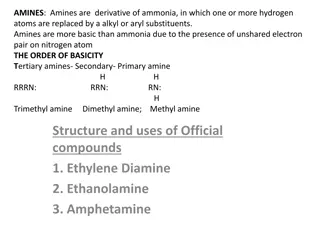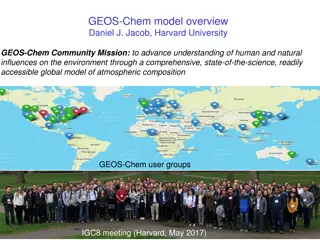
Amines: Structure, Nomenclature, and Physical Properties
Explore the world of amines, organic derivatives of ammonia with unique properties and classifications. Learn about their structure, nomenclature, and physical properties such as solubility. Discover how amines are named and classified based on their molecular composition, essential for understanding their use in various industries.
Uploaded on | 0 Views
Download Presentation

Please find below an Image/Link to download the presentation.
The content on the website is provided AS IS for your information and personal use only. It may not be sold, licensed, or shared on other websites without obtaining consent from the author. If you encounter any issues during the download, it is possible that the publisher has removed the file from their server.
You are allowed to download the files provided on this website for personal or commercial use, subject to the condition that they are used lawfully. All files are the property of their respective owners.
The content on the website is provided AS IS for your information and personal use only. It may not be sold, licensed, or shared on other websites without obtaining consent from the author.
E N D
Presentation Transcript
Amines 1 340 Chem 1st 1439
Outline 2 Structure and Classification Nomenclature Physical Properties Preparation Reaction 340 Chem 1st 1439
Structure and Classification Amines are organic derivatives of ammonia in which one or more hydrogens are replaced with alkyl or aryl groups. Amines are further divided into aliphatic and aromatic amines. It has high degree of biological activity, many amines are used as drugs and medicines. Amines are classified as primary, secondary, or tertiary, depending on the number of carbon atoms bonded directly to nitrogen. In a heterocyclic amine, the nitrogen atom is part of an aliphatic or aromatic ring. 3 340 Chem 1st 1439
Nomenclature of amines A.Common Name of amines 4 Common Names are formed from the names of the alkyl groups bonded to nitrogen, followed by the suffix -amine. The prefixes di-, tri-, and tetra- are used to describe two, three, or four identical substituents. H N CH3 N CH3 H3C H3C NH2 Methylamine Benzyl methyl amine Trimethyl amine 340 Chem 1st 1439
B. IUPAC nomenclature of amines 5 The IUPAC nomenclature for amines is similar to that for alcohols. The longest continuous chain of carbon atoms determines the root name. The - e ending in the alkane name is changed to -amine, and a number shows the position of the amino group along the chain. Other substituents on the carbon chain are given numbers, and the prefix N- is used for each substituent on nitrogen. N H O N H 2 2 O H O H H 2N 5 - M e t h y l - 3 - h e x a n a m i n e 5 - A m i n o h e p t a n o i c a c i d 3 - A m i n o - 2 - b u t a n o l NH CH3 NH2 CH3 N-m ethyl-2-butanam ine CH2 CH CH3 CH3 CH2 CH CH3 H2N CH2 CH2OH 2-Butanam ine 2-Am inoethanol 340 Chem 1st 1439
Naming Of Aromatic Amines 6 Some common arylamines have the following names: Aniline (benzenamine) p-Anisidine (4-methoxybenzenamine) o-Toluidine m-Aminophenol 340 Chem 1st 1439
Physical Properties of Amines Solubility 7 Amines are strongly polar because the large dipole moment of the lone pair of electrons adds to the dipole moments of the C-N and H-N bonds. Primary and secondary amines have N-H bonds, allowing them to form hydrogen bonds. Pure tertiary amines cannot engage in hydrogen bonding because they have no N-H bonds. They can, however, accept hydrogen bonds from molecules having O H or N H bonds. 340 Chem 1st 1439
Boiling point 8 Because nitrogen is less electronegative than oxygen, the N-H bond is less polar than the O-H bond. Therefore, amines form weaker hydrogen bonds than do alcohols of similar molecular weights. Primary and secondary amines have boiling points that are lower than those of alcohols, yet higher than those of ethers of similar molecular weights. With no hydrogen bonding, tertiary amines have lower boiling points than primary and secondary amines of similar molecular weights. 340 Chem 1st 1439
Basicity of Amines: Amine Salts 9 Amines are relatively weak bases. Most are stronger bases than water but are far weaker bases than hydroxide ions, alkoxide ions, and alkanide anions. Aromatic amines less basic than aliphatic amines Electron donating (releasing) groups on N atom increase the basicity Electron withdrawing groups decrease the basicity NH2 NH2 > H > > H3C N CH3 H3C NH2 O2N H3C Most basic Least basic N H2 N H2 N H2 N O2 > > 340 Chem 1st 1439
Aminessyntheses 10 Reduction of nitro compounds Ar-NO2 + H2,Ni Ammonolysis of 1o or methyl halides Ar-NH2 R-X + NH3 Reductive amination R-NH2 R2C=O + NH3, H2, Ni Reduction of nitriles R2CHNH2 R-C N + 2 H2, Ni Hofmann degradation of amides RCH2NH2 RCONH2 + KOBr RNH2 340 Chem 1st 1439
1. Reduction of nitro compounds 11 NH2 NO2 metal + acid; then OH- or H2 + Ni, Pt, or Pd metal + acid; then OH- R NH2 R NO2 or H2 + Ni, Pt, or Pd 340 Chem 1st 1439
CH3 CH3 HNO3,H2SO4 12 + ortho- NO2 H2,Ni CH3 NH2 p-toluidine 340 Chem 1st 1439
2. Ammonolysis of 1o or methyl halides 13 R-X R-X R-X R3N 3o R2NH 2o NH3 RNH2 1o R-X R4N+X- 4o salt R-X must be 1o or CH3 NH3 CH3CH2CH2CH2Br CH3CH2CH2CH2NH2 n-butylamine 340 Chem 1st 1439
CH3Cl 14 CH3CH2CH2NH2 n-propylamine CH3CH2CH2NHCH3 methyl-n-propylamine Et 2 CH3CH2Br NH2 N Et aniline N,N-diethylaniline CH3 (xs) CH3I H2 C NH2 H2 C N CH3 CH3 I benzylamine benzyltrimethylammonium iodide 340 Chem 1st 1439
15 Ammonolysis of alkyl halides is an SN2 reaction. The alkyl halide must be primary or methyl. If the alkyl halide is secondary or tertiary, then an E2 reaction will take place and the product will be an alkene! Br NH2 + NH3 2o RX 340 Chem 1st 1439
SN2 Reactions of Alkyl Halides 16 Ammonia and other amines are good nucleophiles 340 Chem 1st 1439
3. Reductive amination 17 H2, Ni 1o amine CH NH2 + NH3 O or NaBH3CN H2, Ni 2o amine CH NHR + RNH2 O or NaBH3CN H2, Ni 3o amine CH NR2 + R2NH O or NaBH3CN 340 Chem 1st 1439
18 340 Chem 1st 1439
Reductive amination via the imine. 19 O H H2,Ni C NH3 C NH2 H2, Ni OH - H2O C NH2 C NH imine 340 Chem 1st 1439
20 O NH2 NH3, H2/Ni H3CC CH3CHCH3 CH3 isopropylamine acetone CH2CH3 O NH NaBH3CN + CH3CH2NH2 CCH2CH3 CHCH2CH3 propiophenone 1-(N-ethylamino)-1-phenylpropane NH2 O NH3, H2/Ni cyclohexylamine cyclohexanone 340 Chem 1st 1439
4. Reduction of nitriles 21 R-C N + 2 H2, catalyst R-CH2NH2 1o amine R-X + NaCN R-CN RCH2NH2 primary amine with one additional carbon (R must be 1o or methyl) 2 H2, Ni NaCN CH2CH2NH2 CH2Br CH2C N 1-amino-2-phenylethane benzyl bromide 340 Chem 1st 1439
Examples 22 340 Chem 1st 1439
5. Hofmann degradation of amides 23 O KOBr R-NH2 R C NH2 Removes one carbon! CH3 O CH3 OBr CH3C C CH3C NH2 NH2 CH3 CH3 2,2-dimethylpropanamide tert-butylamine 340 Chem 1st 1439
24 Outline possible laboratory syntheses for each of the following amines, starting with toluene. Use a different method for each compound. H3C NH2 NH2 aniline p-toluidine NH2 CH2CH2NH2 H3C CHCH3 1-amino-2-phenylethane 1-amino-1-(p-tolyl)ethane CH2NH2 benzylamine 340 Chem 1st 1439
Hofmann and Curtius Rearrangements 25 Carboxylic acid derivatives can be converted into primary amines with loss of one carbon atom by both the Hofmann rearrangement and the Curtius rearrangement 340 Chem 1st 1439
Hofmann rearrangement 26 O 1. deprotonation of the amide by the base to form an anion which then attacks the halogen to form a N-haloamide. NaOH, Br2 R-NH2 + CO2 R NH2 H2O prim amide 2. deprotonation by the base provides an anion that rearranges to an isocyanate intermediate and releases a halide anion. O O O O OH2 OH OH Br-Br Br R N Br R N C O R N H R N H R NH2 Isocyanate O O Br R N Br R N H 3. The isocyanate is attacked by water which after a series of proton transfer step results in a zwitterionic intermediate, containing an ammonium cation and a carboxylate anion. 4. Thermal conditions result in the explosion of carbon dioxide gas and quenching of the ammonium cation to the amine product O H R H2N R O N H - CO2 carbamic acid instable 340 Chem 1st 1439
Curtius rearrangement 27 O R-NH2 + CO2 R N3 H2O, heat + N2 acyl azide acyl azide O O OH2 N3 R-NH2 R N C O R N R Cl NN - CO2 Isocyanate acyl halide O R N NN Mechanistic. related to Hofmann rearrang. O O OH2 R-NH2 R N Br R N C O R NH2 - CO2 Isocyanate O R N Br 340 Chem 1st 1439
Amine Reactions 28 Reaction as Bases: Salt Formation HCl R-NH2 R-NH3Cl Amide Formation O O ` ` R-NH2 + R C NHR R C Cl Reaction with Nitrous Acid 340 Chem 1st 1439
Amine Reactions with Nitrous Acid 29 Primary amines: Diazotization Secondary Amines: Nitrosamine formation Tertiary Amines: C-nitroso com 340 Chem 1st 1439
Mechanism of Diazonium salt formation 1 30 340 Chem 1st 1439
Mechanism of Diazonium salt formation 2 31 340 Chem 1st 1439
Diazonium Salt Reactions 32 HO N N an azo dye OH I H2O KI Phenol heat + CN N N Cl CuCN CuCl 1. HBF4 H3PO2 CuBr 2. heat Br F H 340 Chem 1st 1439

